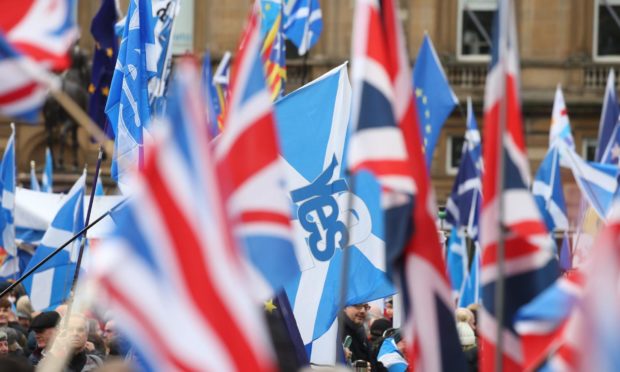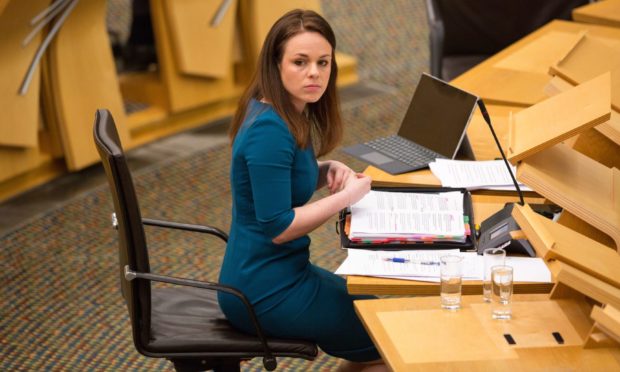A deficit of £36billion in Scotland’s finances has not undermined the case for independence, according to finance secretary Kate Forbes.
The senior SNP minister said the gap between revenue and spending should pose no obstacle to pushing the case for full powers in Edinburgh.
The Highland MSP’s comments sparked another row with pro-union politicians who claim Scotland has been helped through a devastating pandemic thanks to the wider UK.
The latest annual report on government expenditure and revenue, published on Wednesday morning, shows the gap in the balance sheet rose from 8.6% before the pandemic to 22.4% in 2020-21.
It compares with around 14% across the UK.
Asked what this means for the SNP’s referendum push, Ms Forbes said the pandemic “strengthens” Scotland’s hand in calling for more powers.
It is not an obstacle to making the case for independence.”
Kate Forbes
She also claimed Scotland’s finances are “engineered” to be reliant on the UK Treasury, giving an unclear picture for a financial analysis of independence.
“It is not an obstacle to making the case for independence,” she said in a Scottish Government briefing on the latest set of figures.
“Deficits across the world have risen exponentially and having the highest deficit in Europe does not seem to be an obstacle to the UK Government being independent. The same argument would apply to us.”
Covid storm
Ms Forbes said people “assume” the UK Government will manage their deficit down, suggesting it would be no different for Scotland as an independent state.
“That is what countries around the world are doing,” she said.
“There is a strengthened argument to grow our economy. I can only go so far without the full levers at our control.”
Conservatives seized on the annual snapshot to promote the value of the UK Treasury and government.
Tory MP Alister Jack, the UK Government Scottish Secretary, said: “We have been able to weather the Covid storm as part of the UK but we now face the challenge of rebuilding our economy and supporting our heroic NHS and other public services. Our focus remains on that task.
“We have faced a terrible crisis far, far stronger as one UK – and we will build back better as one UK.”
Scottish Labour deputy leader Jackie Baillie said pushing for a referendum now is “reckless”.
She said: “The additional £1,828 spent per person in Scotland compared to the rest of the UK is what goes to maintaining the schools, transport and NHS on which we all rely.
“The ongoing economic fallout of the pandemic and the unanswered question of separation remain the largest long-term economic threats to Scotland’s prosperity.”
What do the official figures show?
- The 2020-21 Government expenditure and revenue figures help to illustrate the notional gap in the balance sheet, including capital investment.
- The net balance with a geographic share of North Sea revenue was a deficit of 22.4%, equal to £36.3billion. That is an increase from 8.6%, or £15.1bn, before the pandemic struck.
- When North Sea revenue is excluded, the latest deficit is 23.8%, or £36.9bn. This compares with the UK deficit of 14.2% of gross domestic product.
- Public sector revenue was estimated at £62.8bn, which is 7.9% of UK revenue.
- North Sea revenue was down from £800 million to £500 million.
- The figures show total spending was equivalent to £18,144 per person. That is £1,828 per person higher than the UK average.
The Institute for Fiscal Studies said the government would have to cut spending or increase taxes to deal with the deficit, if Scotland became independent.
David Phillips, associate director at the institute, said: “Only in the unlikely event of a massive rebound in oil revenues or a rapid and large improvement in economic performance-boosting tax revenues could such measures be avoided.”
Asked if taxes will rise in the next Scottish budget, Ms Forbes said there are no plans to make changes to rates.
‘Blistering’
Scottish Liberal Democrat Treasury spokeswoman Christine Jardine said: “These blistering figures drive home just how economically valuable the partnership across these isles is.”
Scottish Greens co-leader Patrick Harvie, whose party backs independence, said the figures always lead to a predictable row.
“Each year the same people leap on it to make the same points about the constitution, when it tells us nothing about the real economic challenges and choices facing us,” he said.
“The economic impact of the pandemic has been widely predicted and we shouldn’t be surprised at that.
“But it’s important to recognise what’s happening underneath the headline figures. The super-rich grew their vast wealth during the pandemic, while the majority struggled.”
More from the politics team
Analysis: What does the Gers report tell us about an independent Scotland?

